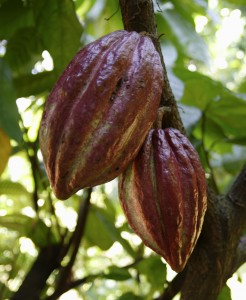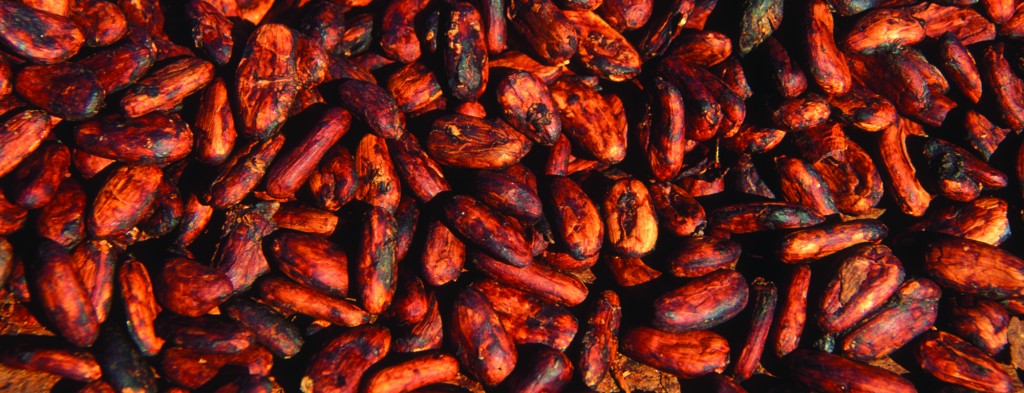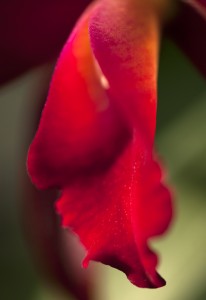Valentine’s Day in the Haupt Conservatory
Posted in Science on January 30 2013, by Christian Primeau
Christian Primeau is the NYBG‘s Manager of the Enid A. Haupt Conservatory.

An ex-girlfriend once observed in my presence: “Chocolate and men… some things are just better rich.” Understandably, she didn’t last long. Between the basic cable package and my favorite old jeans with the hole in the knee, I figure our relationship was more than her soul could endure. But let’s be honest–you don’t have to be a millionaire to make your significant other truly happy this Valentine’s Day. Money may not buy love, but–and it pains me to say it–she was right about one thing: the chocolate. Go ahead and upgrade the cable package, because you’ll be spending plenty of time on the living room couch if you forget to pick up the good stuff.
Once you’ve secured a delicious prize for your sweetheart, what better way to accumulate a few extra points than regaling them with the epic story of chocolate; its fantastic history and that mysterious process by which cacao makes its way from the deepest rain forests to that cellophane-wrapped, heart-shaped box gathering dust on the shelf of your local drug store? The object of your desire will undoubtedly wonder at your knowledge of obscure things and immediately find you more intriguing. You’re welcome in advance, friends.
The Cacao (cocoa) tree, or Theobroma cacao to geeks like me, originated in the moist, shady understory of the Amazon River Basin of South America and was actually believed by the Mayans to have divine origins. Roughly translated in Greek, Theobroma means food (broma) of the Gods (theos). The tiny white and pink flowers of this revered tree emerge along the woody trunk and branches (an unusual process referred to as cauliflory) and are consequently pollinated by a handful of equally miniscule midge fly species. When ripe, the leathery, pod-like yellow to orange fruit is harvested and the seeds removed and fermented. Much like coffee, the seeds of cacao were traditionally roasted, ground and mixed with water and spices to form a beverage or thin porridge which native Central and South Americans cherished. In fact, it was the wise Aztec Emperor Montezuma who once advised, “Oh, hey–just dip it in chocolate; it’ll be fine.”

In the 1540s, the Spanish conquistador Hernan Cortes would “borrow” a few boatloads of these precious seeds from the Aztecs (in exchange for smallpox and typhus) and thereby introduce cacao to the Western world. It was there that a burgeoning number of European chocophiles would forge ahead assiduously, continuously experimenting with cacao powder. They first mixed it with sugar, then butter, and eventually milk, finally hitting on the winning formula for the decadent modern-day treat we treasure.
Now, centuries later, Montezuma’s sage advice still holds true. Everything is better with chocolate–even love. Wait, let me amend that: especially love. So get out there and pick some up before the shelves are empty. Then bring your Valentine for a romantic stroll through the lowland rain forest houses here at the Enid A. Haupt Conservatory, and maybe steal a smooch under the ripening cacao fruit. Good luck and Happy Valentine’s Day everybody!
 Thanks to MasterCard’s Priceless NY promotions, the Enid A. Haupt Conservatory is soon set to become the most romantic spot in the boroughs. While tickets are currently SOLD OUT for our February 10 Valentine’s evening, keep an eye out for updates on possible new ticket releases, or sign up for our direct ticket alerts to have us notify you immediately.
Thanks to MasterCard’s Priceless NY promotions, the Enid A. Haupt Conservatory is soon set to become the most romantic spot in the boroughs. While tickets are currently SOLD OUT for our February 10 Valentine’s evening, keep an eye out for updates on possible new ticket releases, or sign up for our direct ticket alerts to have us notify you immediately.

